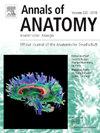谢尔曼氏脊柱侧弯对肋骨形态的影响:骨骼研究。
IF 2
3区 医学
Q2 ANATOMY & MORPHOLOGY
引用次数: 0
摘要
背景:人类肋骨笼形态的进化变化使其容易发生病变,如舍尔曼氏脊柱侧弯症(SK)。目的:本研究旨在探讨SK患者与对照组之间在肋骨笼形态(如肋骨和胸骨)方面的差异:从 SK 患者(76 例)和对照组(96 例)的骨骼中测量椎体、横突角、胸骨和肋骨的尺寸。对研究组和对照组之间以及左右两侧之间的差异进行了统计检验。对脊柱后凸的程度(后凸角度)和肋骨笼变量之间的相关性进行了检验:结果:SK 组的肋骨明显比对照组的肋骨更长、更平,男女均是如此。然而,男性第 9 肋骨和女性上肋骨的差异最大(5-7)。性别间的对称性结果不一致。总之,与对照组相比,SK 患者的前胸直径相对于横径较大:讨论和结论:SK 会影响整个胸廓的形态,并同样改变男性和女性的肋骨比例。这些变化可能会影响两足的稳定性和运动效率。此外,在采用前路松解和前路融合手术方法时,了解 SK 患者的独特解剖结构至关重要。最后,它还为患有严重脊柱后凸的患者的呼吸系统并发症和不良预后提供了见解。本文章由计算机程序翻译,如有差异,请以英文原文为准。
The effect of Scheuermann's kyphosis on rib cage morphology: A skeletal study
Background
Evolutionary changes in human rib cage morphology rendered it prone to pathologies like Scheuermann's kyphosis (SK). However, the impact of SK on rib cage morphology is unclear.
Purpose
This study aimed to examine differences in rib cage morphology (e.g., ribs and sternum) between SK patients and a control group.
Methods
Measurements of the vertebral body, transverse process angle, sternum, and rib size were taken from the skeletons of SK patients (76) and a control group (96). Statistical tests were carried out to examine differences between the study and control groups and between the right and left sides. Correlations were obtained to examine the associations between the extent of the kyphosis (kyphosis angle) and rib cage variables.
Results
The SK group yielded significantly longer and flatter ribs than the control group in both sexes. However, males had the largest differences in the 9th rib and females in the upper ribs (5−7). Inconsistency in symmetry results was found between the sexes. In summary, SK patients had a larger anteroposterior diameter in relation to the transverse diameter than the control group.
Discussion and Conclusions
SK affects the morphology of the entire thorax and changes rib proportions similarly in males and females. These changes might have a role in bipedal stability and locomotion efficiency. Moreover, understanding the unique anatomy of SK patients is essential when performing an anterior release and anterior fusion operative approach. Finally, it provides insights into respiratory complications and poor prognosis related to individuals suffering from severe hyperkyphosis.
求助全文
通过发布文献求助,成功后即可免费获取论文全文。
去求助
来源期刊

Annals of Anatomy-Anatomischer Anzeiger
医学-解剖学与形态学
CiteScore
4.40
自引率
22.70%
发文量
137
审稿时长
33 days
期刊介绍:
Annals of Anatomy publish peer reviewed original articles as well as brief review articles. The journal is open to original papers covering a link between anatomy and areas such as
•molecular biology,
•cell biology
•reproductive biology
•immunobiology
•developmental biology, neurobiology
•embryology as well as
•neuroanatomy
•neuroimmunology
•clinical anatomy
•comparative anatomy
•modern imaging techniques
•evolution, and especially also
•aging
 求助内容:
求助内容: 应助结果提醒方式:
应助结果提醒方式:


